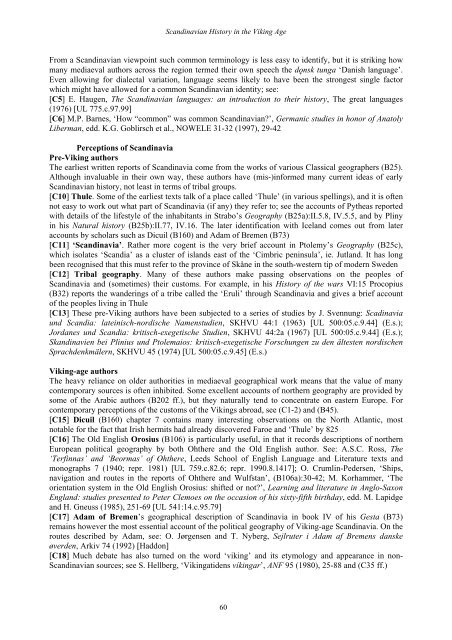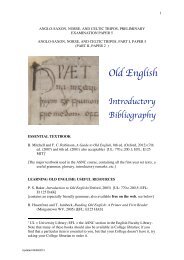Scandinavian history in the Viking age - Department of Anglo-Saxon ...
Scandinavian history in the Viking age - Department of Anglo-Saxon ...
Scandinavian history in the Viking age - Department of Anglo-Saxon ...
Create successful ePaper yourself
Turn your PDF publications into a flip-book with our unique Google optimized e-Paper software.
<strong>Scand<strong>in</strong>avian</strong> History <strong>in</strong> <strong>the</strong> Vik<strong>in</strong>g Age<br />
From a <strong>Scand<strong>in</strong>avian</strong> viewpo<strong>in</strong>t such common term<strong>in</strong>ology is less easy to identify, but it is strik<strong>in</strong>g how<br />
many mediaeval authors across <strong>the</strong> region termed <strong>the</strong>ir own speech <strong>the</strong> d²nsk tunga ‘Danish langu<strong>age</strong>’.<br />
Even allow<strong>in</strong>g for dialectal variation, langu<strong>age</strong> seems likely to have been <strong>the</strong> strongest s<strong>in</strong>gle factor<br />
which might have allowed for a common <strong>Scand<strong>in</strong>avian</strong> identity; see:<br />
[C5] E. Haugen, The <strong>Scand<strong>in</strong>avian</strong> langu<strong>age</strong>s: an <strong>in</strong>troduction to <strong>the</strong>ir <strong>history</strong>, The great langu<strong>age</strong>s<br />
(1976) [UL 775.c.97.99]<br />
[C6] M.P. Barnes, ‘How “common” was common <strong>Scand<strong>in</strong>avian</strong>?’, Germanic studies <strong>in</strong> honor <strong>of</strong> Anatoly<br />
Liberman, edd. K.G. Goblirsch et al., NOWELE 31-32 (1997), 29-42<br />
Perceptions <strong>of</strong> Scand<strong>in</strong>avia<br />
Pre-Vik<strong>in</strong>g authors<br />
The earliest written reports <strong>of</strong> Scand<strong>in</strong>avia come from <strong>the</strong> works <strong>of</strong> various Classical geographers (B25).<br />
Although <strong>in</strong>valuable <strong>in</strong> <strong>the</strong>ir own way, <strong>the</strong>se authors have (mis-)<strong>in</strong>formed many current ideas <strong>of</strong> early<br />
<strong>Scand<strong>in</strong>avian</strong> <strong>history</strong>, not least <strong>in</strong> terms <strong>of</strong> tribal groups.<br />
[C10] Thule. Some <strong>of</strong> <strong>the</strong> earliest texts talk <strong>of</strong> a place called ‘Thule’ (<strong>in</strong> various spell<strong>in</strong>gs), and it is <strong>of</strong>ten<br />
not easy to work out what part <strong>of</strong> Scand<strong>in</strong>avia (if any) <strong>the</strong>y refer to; see <strong>the</strong> accounts <strong>of</strong> Py<strong>the</strong>as reported<br />
with details <strong>of</strong> <strong>the</strong> lifestyle <strong>of</strong> <strong>the</strong> <strong>in</strong>habitants <strong>in</strong> Strabo’s Geography (B25a):II.5.8, IV.5.5, and by Pl<strong>in</strong>y<br />
<strong>in</strong> his Natural <strong>history</strong> (B25b):II.77, IV.16. The later identification with Iceland comes out from later<br />
accounts by scholars such as Dicuil (B160) and Adam <strong>of</strong> Bremen (B73)<br />
[C11] ‘Scand<strong>in</strong>avia’. Ra<strong>the</strong>r more cogent is <strong>the</strong> very brief account <strong>in</strong> Ptolemy’s Geography (B25c),<br />
which isolates ‘Scandia’ as a cluster <strong>of</strong> islands east <strong>of</strong> <strong>the</strong> ‘Cimbric pen<strong>in</strong>sula’, ie. Jutland. It has long<br />
been recognised that this must refer to <strong>the</strong> prov<strong>in</strong>ce <strong>of</strong> Skåne <strong>in</strong> <strong>the</strong> south-western tip <strong>of</strong> modern Sweden<br />
[C12] Tribal geography. Many <strong>of</strong> <strong>the</strong>se authors make pass<strong>in</strong>g observations on <strong>the</strong> peoples <strong>of</strong><br />
Scand<strong>in</strong>avia and (sometimes) <strong>the</strong>ir customs. For example, <strong>in</strong> his History <strong>of</strong> <strong>the</strong> wars VI:15 Procopius<br />
(B32) reports <strong>the</strong> wander<strong>in</strong>gs <strong>of</strong> a tribe called <strong>the</strong> ‘Eruli’ through Scand<strong>in</strong>avia and gives a brief account<br />
<strong>of</strong> <strong>the</strong> peoples liv<strong>in</strong>g <strong>in</strong> Thule<br />
[C13] These pre-Vik<strong>in</strong>g authors have been subjected to a series <strong>of</strong> studies by J. Svennung: Scad<strong>in</strong>avia<br />
und Scandia: late<strong>in</strong>isch-nordische Namenstudien, SKHVU 44:1 (1963) [UL 500:05.c.9.44] (E.s.);<br />
Jordanes und Scandia: kritisch-exegetische Studien, SKHVU 44:2a (1967) [UL 500:05.c.9.44] (E.s.);<br />
Skand<strong>in</strong>avien bei Pl<strong>in</strong>ius und Ptolemaios: kritisch-exegetische Forschungen zu den ältesten nordischen<br />
Sprachdenkmälern, SKHVU 45 (1974) [UL 500:05.c.9.45] (E.s.)<br />
Vik<strong>in</strong>g-<strong>age</strong> authors<br />
The heavy reliance on older authorities <strong>in</strong> mediaeval geographical work means that <strong>the</strong> value <strong>of</strong> many<br />
contemporary sources is <strong>of</strong>ten <strong>in</strong>hibited. Some excellent accounts <strong>of</strong> nor<strong>the</strong>rn geography are provided by<br />
some <strong>of</strong> <strong>the</strong> Arabic authors (B202 ff.), but <strong>the</strong>y naturally tend to concentrate on eastern Europe. For<br />
contemporary perceptions <strong>of</strong> <strong>the</strong> customs <strong>of</strong> <strong>the</strong> Vik<strong>in</strong>gs abroad, see (C1-2) and (B45).<br />
[C15] Dicuil (B160) chapter 7 conta<strong>in</strong>s many <strong>in</strong>terest<strong>in</strong>g observations on <strong>the</strong> North Atlantic, most<br />
notable for <strong>the</strong> fact that Irish hermits had already discovered Faroe and ‘Thule’ by 825<br />
[C16] The Old English Orosius (B106) is particularly useful, <strong>in</strong> that it records descriptions <strong>of</strong> nor<strong>the</strong>rn<br />
European political geography by both Oh<strong>the</strong>re and <strong>the</strong> Old English author. See: A.S.C. Ross, The<br />
‘Terf<strong>in</strong>nas’ and ‘Beormas’ <strong>of</strong> Oh<strong>the</strong>re, Leeds School <strong>of</strong> English Langu<strong>age</strong> and Literature texts and<br />
monographs 7 (1940; repr. 1981) [UL 759.c.82.6; repr. 1990.8.1417]; O. Cruml<strong>in</strong>-Pedersen, ‘Ships,<br />
navigation and routes <strong>in</strong> <strong>the</strong> reports <strong>of</strong> Oh<strong>the</strong>re and Wulfstan’, (B106a):30-42; M. Korhammer, ‘The<br />
orientation system <strong>in</strong> <strong>the</strong> Old English Orosius: shifted or not?’, Learn<strong>in</strong>g and literature <strong>in</strong> <strong>Anglo</strong>-<strong>Saxon</strong><br />
England: studies presented to Peter Clemoes on <strong>the</strong> occasion <strong>of</strong> his sixty-fifth birthday, edd. M. Lapidge<br />
and H. Gneuss (1985), 251-69 [UL 541:14.c.95.79]<br />
[C17] Adam <strong>of</strong> Bremen’s geographical description <strong>of</strong> Scand<strong>in</strong>avia <strong>in</strong> book IV <strong>of</strong> his Gesta (B73)<br />
rema<strong>in</strong>s however <strong>the</strong> most essential account <strong>of</strong> <strong>the</strong> political geography <strong>of</strong> Vik<strong>in</strong>g-<strong>age</strong> Scand<strong>in</strong>avia. On <strong>the</strong><br />
routes described by Adam, see: O. Jørgensen and T. Nyberg, Sejlruter i Adam af Bremens danske<br />
øverden, Arkiv 74 (1992) [Haddon]<br />
[C18] Much debate has also turned on <strong>the</strong> word ‘vik<strong>in</strong>g’ and its etymology and appearance <strong>in</strong> non-<br />
<strong>Scand<strong>in</strong>avian</strong> sources; see S. Hellberg, ‘Vik<strong>in</strong>gatidens vík<strong>in</strong>gar’, ANF 95 (1980), 25-88 and (C35 ff.)<br />
60






